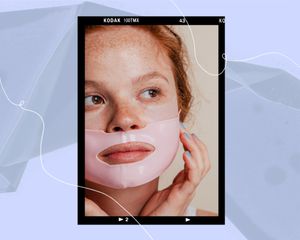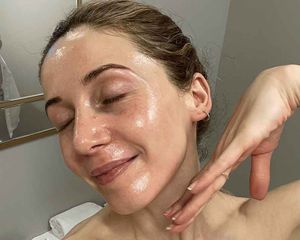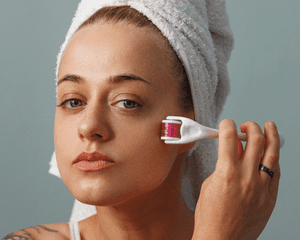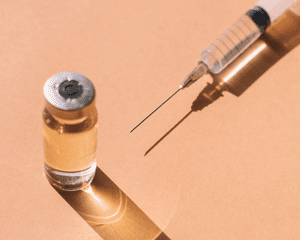:max_bytes(150000):strip_icc()/facialinjectables-c271722f00eb480a94885fe37540a20b.png)
Stocksy
If you've been to Sephora lately or even scrolled on TikTok, you're probably well aware that there are tons of new beauty brands hitting the scene, but the lesser-known fact is that injectable brands are flooding the market as well. So, it's not always as simple as just deciding you want to get botulinum toxin injections (such as Botox) or filler. The next step is to weigh your options because as with most things, injectables aren't one size fits all.
When it comes to filler, there are more than a few to choose from, and not only might their ingredients list differ, but the molecular sizes of the ingredients can vary as well, meaning the results won't be identical. There are two principal manufacturers of injectable filler: the publicly traded company Allergan, and Galderma, a wholly-owned subsidiary of Nestlé (yes, like the chocolate). In June 2006, the FDA approved Juvéderm, a family of hyaluronic acid (HA) dermal fillers for long-lasting correction of facial wrinkles and folds. In addition to Allergan and Galderma, companies including Merz Aesthetics and Suneva Medical Inc. have also manufactured dermal fillers to address various facial concerns, such as smoothing wrinkles and adding volume to sunken or depressed areas.
And just because you've heard of one type of filler doesn't necessarily mean it's the best. You should consider factors such as placement, how long you want your results to last, whether or not you want the results to be reversible should you not be satisfied with the results, and FDA approval. These are conversations you should definitely have with your injector, but in the meantime, we tapped two experts to get a general overview of the best types of face fillers. Below, cosmetic dermatologist Marnie Nussbaum, MD, and facial plastic surgeon Jonathan Cabin, MD, share everything they know.
Meet the Expert
- Marnie Nussbaum, MD is a board-certified dermatologist specializing in non-invasive aesthetic rejuvenation.
- Jonathan Cabin, MD is a facial plastic and reconstructive surgeon with expertise in surgical and non-surgical procedures.
Hyaluronic Acid (HA)
Hyaluronic acid (HA) fillers are one of the most popular as they have a soft texture that creates natural-looking results. HA is found naturally in your body, so it dissolves naturally and gradually over time, generally between 6 to 12 months depending on the individual and the product used. The Juvéderm line by Allergan is one of the most well-known of the HA fillers. They are also the manufacturer of the widely-known and trademarked botulinum toxin wrinkle treatment, Botox, along with several models of the most commonly used silicone breast implants. It’s safe to say that Allergan dominates much of the cosmetic enhancement market. Juvéderm is a natural, biodegradable product, as is Galderma’s version called Restylane, and its family of competitive HA dermal fillers.
The type of filler your doctor will choose will vary depending on where you are getting it, the problem it is addressing, and the results you are looking for. Meet the product lineup of HA fillers for each brand and get an idea of how some of these fillers will best work for your needs. As you can see, there are quite a few options so it is best to go to a qualified doctor who can best pick out the right type of filler for you.
Juvéderm:
- Juvéderm Voluma XC: This filler is often used for the cheekbones, chin, and jawline. “Juvéderm Voluma XC via blunt-tip cannula," says Dr. Cabin, referring to his pick of fillers for the cheekbones. "It’s a thick filler, so it adds structure and support. It is also the longest-lasting HA filler (up to 2 years), so it is the best financial investment for this region.”
- Juvéderm Ultra XC: This filler is a great choice for the cheekbones, chin, nasolabial folds, lips, and jawline. "If someone wants big lips, has super de-volumized lips, or needs me to build a lot of shape and structure, I opt for Juvéderm Ultra XC via needle. It is thicker than Juvéderm Volbella XC, and it loves water, so the lips can hold better shape and get super juicy," says Dr. Cabin. In addition, Dr. Nussbaum likes using this to give the cheekbones a lift if someone has thinner skin.
- Juvéderm Volbella XC: This filler is another great choice for getting juicy lips. “If I have to choose one, Juvéderm Volbella XC via needle," says Dr. Cabin. "Most of my patients want a natural, hydrated, augmented lip, and are rarely in the market for the Kardashian/Jenner effect. In these cases, I go with Juvéderm Volbella XC for two reasons: It comes in a 0.6cc syringe (instead of the typical 1cc syringes most other fillers come in), and patients generally don’t need more than this in their lips. It is soft and natural-looking and, most importantly, feeling. So, in kissing your partner, it is least likely to feel any different than a normal lip.
- Juvéderm Vollure XC: This product is recommended for the jawline and nasolabial folds. " A lot of times the nasolabial folds refer to two things: The 'shadowing' next to the nostril (called 'deep pyriform space' or 'ristow’s space') created by the loss of soft tissue and bony volume in this area, and the deep crease or superficial wrinkle that extends from this area down to the corner of the mouth," says Dr. Cabin. "Assuming you have to address both of these areas, I consider Juvéderm Vollure XC a 'hybrid' filler that can do both deep and superficial work. It also lasts 18 months, which is a nice bonus.”
- Juvéderm Ultra Plus XC: This filler has a thicker consistency and is used in areas that have deeper wrinkles or in the nasolabial folds.
Restylane
The HA dermal filler Restylane is by Galderma and their lineup of products is also made to address a wide range of concerns.
- Restylane: Drs. Cabin and Nussbaum both prefer this product for under the eyes and the tear troughs. “Restylane with cannula," says Dr. Cabin, on his preferred technique. "Under-eye filler is the most challenging in my hands and the most overused in our industry. The most important consideration with under-eye filler is that a filler takes in as little water as possible (or, in technical terms, is relatively 'hydrophobic'). Otherwise, you’ll trade under-eye hollows with bags made mostly of water. Restylane is relatively hydrophobic, and tends to look the most natural under the eyes.” Dr. Nussbaum agrees, saying: “Tear troughs need a filler that will not draw in a ton of water, while also avoiding the Tyndall effect (the bluish tint under the skin). Therefore, Restylane is ideal for this area.” And as of 2023, Restylane Eyelight, the brand's eye-specific filler is FDA-approved. It is technically the same HA formula that doctors have been using under the eye for years but with a smaller syringe that prevents over-injecting the delicate under-eye area.
- Restylane Defyne: This product is great for enhancing your jawline. “The jawline needs definition," says Dr. Nussbaum. "Therefore, Juvéderm Ultra XC, Juvéderm Voluma XC, or Restylane Defyne may be used.”
- Restylane Refyne: According to the brand, This filler is made to help soften and minimize laugh lines, nasolabial folds, and marionette lines.
- Restylane Lyft: Dr. Nussbaum either uses this filler or a Juvéderm product to give the cheekbones a nice lift. “The cheekbones generally need more of a lift than the lower face. Therefore, we would use a filler with a high G Prime and particle size, such as Juvéderm Voluma XC, Restylane Lyft, or even Juvéderm Ultra XC if the skin is thin," she says.
- Restylane Silk: This product is administered with an ultra-fine needle and is FDA approved for the lips to smooth those stubborn wrinkles around the mouth.
- Restylane Kysse: This product is also made to enhance the lips and has lidocaine to ease the injection pain. It lasts up to one year.
- Restylane Contour: This filler is used for cheekbones and to give more lift and definition to the contours of the midface.
Byrdie Tip
“Nasolabial folds usually need a finer particle size and have an easier flow. Therefore, Restylane, Juvéderm Ultra XC, or Juvéderm Vollure XC may be utilized, depending upon the patient's needs," says Dr. Nussbaum.
In addition to Restylane and Juvéderm, there are other options for HA dermal fillers as well.
Belotero Balance: This product by Merz Aesthetics is an FDA-approved dermal filler to smooth nasolabial folds. It lasts six months to one year.
Revanesse Versa: This product is another FDA-approved dermal HA filler for moderate to severe wrinkles, including nasolabial folds.
The RHA collection: The RHA (Resilient Hyaluronic Acid) collection is an FDA-approved filler that uses new HA technology that is designed to treat "dynamic" wrinkles and folds. It is touted to give a more natural look, with results lasting 9-18 months.
Calcium Hydroxylapatite (CaHA)
Like HA fillers, Calcium Hydroxylapatite (CaHA) is also found naturally in our bodies– mostly in our bones. The microscopic calcium particles are in the filler, and this makes this product thicker than an HA filler. It also lasts longer than HA fillers as it can give results up to one year.
Radiesse by Merz Aesthetics is the FDA-approved CaHA filler. This product is used to smooth and minimize nasolabial folds and improve the contours of the jawline. "Posterior jawline (toward the angle of the jaw), just like filling the chin and cheeks, is building onto bone," says Dr. Cabin, who says he uses Juvéderm Voluma XC.
Radiesse is also FDA-approved to use in the hands, to increase volume and minimize the look of veins and tendons.
Poly-L-lactic Acid
Poly-L-lactic acid is not naturally found in the body like the fillers above. However, they are a biodegradable synthetic substance that is safe to use in our bodies. Because of this, they last much longer than the fillers above and can give results for up to two years. This product can actually help stimulate and rebuild collagen in the skin. Poly-L-lactic has been used in the medical field for many years, in products such as dissolvable stitches.
Sculptra by Galderma is an FDA-approved Poly-L-lactic acid dermal filler. It is used for smile lines, nasolabial folds, and chin wrinkles. This product is also beneficial to restore volume to hollow cheeks or temples. It helps to stimulate collagen to restore volume to the face.
Byrdie Tip
Filler products can be injected via a needle or a blunt-tip cannula. Typically, using the cannula technique helps to reduce bruising and swelling. It’s up to the discretion of the injector which technique is best for which filler and in what area, but we strongly recommend you go to a professional who is trained in both methods.
Polymethylmethacrylate (PMMA)
Similar to Poly-L-lactic acid, PMMA is not naturally occurring but is a synthetic, biocompatible substance that is used in dermal fillers. It has been used in the medical and dental fields for many years. When used as a filler, PMMA is a microsphere that is in a collagen gel that helps to plump up and provide support to the skin. It lasts much longer than HA fillers.
Bellafill by Suneva Medical Inc. is the FDA-approved PMMA filler. It is used in the smile lines and nasolabial folds and can also help smooth acne scars. The microspheres in the filler also help your body create its own natural collagen to maintain the volume in your face. It is the only FDA-approved filler that can last for up to five years.
Autologous fat injections (facial fat grafting)
Unlike the other fillers, facial fat grafting requires surgery as it is using your own fat that is then injected into your face to restore volume. Fat is removed through liposuction from other areas, like your abdomen, and then injected into areas like your temples, cheeks, or lips. The results can last for a long time and can even be permanent. However, note that it may require more than one session to achieve the results you want. Make sure you are going to a board-certified cosmetic surgeon for this procedure.
As you can see, you have many options for facial fillers to help you achieve the look you want. "The thing about filler is to use the correct filler for the right patient in the right amount,” Dr. Nussbaum emphasizes.








